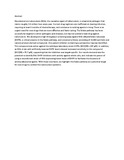High-throughput screening and sensitized bacteria identify an M. tuberculosis dihydrofolate reductase inhibitor with whole cell activity.

View/
Date
2012Author
Kumar, A
Zhang, M
Zhu, L
Liao, RP
Mutai, C
Hafsat, S
Sherman, DR
Wang, MW
Type
ArticleLanguage
enMetadata
Show full item recordAbstract
Mycobacterium tuberculosis (Mtb), the causative agent of tuberculosis, is a bacterial pathogen that claims roughly 1.4 million lives every year. Current drug regimens are inefficient at clearing infection, requiring at least 6 months of chemotherapy, and resistance to existing agents is rising. There is an urgent need for new drugs that are more effective and faster acting. The folate pathway has been successfully targeted in other pathogens and diseases, but has not yielded a lead drug against tuberculosis. We developed a high-throughput screening assay against Mtb dihydrofolate reductase (DHFR), a critical enzyme in the folate pathway, and screened a library consisting of 32,000 synthetic and natural product-derived compounds. One potent inhibitor containing a quinazoline ring was identified. This compound was active against the wild-type laboratory strain H37Rv (MIC(99) = 207 µM). In addition, an Mtb strain with artificially lowered DHFR levels showed increased sensitivity to this compound (MIC(99) = 70.7 µM), supporting that the inhibition was target-specific. Our results demonstrate the potential to identify Mtb DHFR inhibitors with activity against whole cells, and indicate the power of using a recombinant strain of Mtb expressing lower levels of DHFR to facilitate the discovery of antimycobacterial agents. With these new tools, we highlight the folate pathway as a potential target for new drugs to combat the tuberculosis epidemic.
URI
http://www.ncbi.nlm.nih.gov/pubmed/22768185http://erepository.uonbi.ac.ke:8080/xmlui/handle/123456789/57814
